In this final installment of our Hearing Effects series we’ll complete our discussion of modulation effects by looking at tremolo, vibrato, pitch shift and wah-wah effects.
First things first – I know you’ve been waiting to find out the answer to our last Bonus Question, from our article on Reverb Effects:
Who is the original wah-wah effect named after – and why?
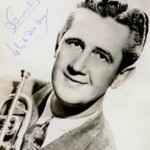 It was jazz trumpet player Clyde McCoy. The reason the first wah-wah’s were named after Clyde is simply due to the fact that it was the electronic answer to the muted trumpet sound (utilizing a trumpet mute plunger) that McCoy had developed and used.
It was jazz trumpet player Clyde McCoy. The reason the first wah-wah’s were named after Clyde is simply due to the fact that it was the electronic answer to the muted trumpet sound (utilizing a trumpet mute plunger) that McCoy had developed and used.
In 1967, Vox introduced the first “Clyde McCoy” wah-wah. This became the blueprint, and the rest; well, you know how these things go.
Nowadays, there are themes and variations on the wah-wah concept, just as there are themes and variations on all of the other audio effects we’ve discussed so far.
We’ll take a closer look at the functional and technical details of the wah-wah below. But we have a few other effects to cover first…
Tremolo/Vibrato Effects
The next stop on our tour is the dominion of tremolo and vibrato effects.
Right off the bat: this pair of effects uses just the “wet” signal and does not require it to be mixed with the original/”dry” signal to produce the effect. If you remember last week’s definition of modulation effects and the discussion of chorus and flanger effects, you’ll understand why we’re pointing this out as a difference. If not, go back and refresh your memory before we continue on.
Tremolo
Tremolo in its simplest form is an effect based on volume amplitude modulation; that is, the volume of the signal gets turned up and down. That’s it… volume up and down. A signal is fed into the tremolo unit and its volume is made to rise and fall according to three main controls: speed, depth, and (more recently) shape too!
The end result is the deep throbbing sound that bubbles up to full volume and then disappears into oblivion before repeating the whole cycle again.
The first and earliest examples of this effect were built into Vox and Fender amplifiers, and were all the rage; especially with surf music of the ‘50s and ‘60s. As usual, these effects have stood the test of time; and far from becoming outdated have actually found steady work in all forms of music and sound creation today.
The controls for tremolo effects are rather basic, but crucial to know nonetheless:
- The speed control determines the rate at which the signal rises and falls in volume.
- The depth control determines how far the volume will rise and fall.
(Maximum volume to minimum volume, or something more subtle and in between?) - The shape control determines the manner in which the volume is changed
The speed and depth controls are easy to grasp. However, the real magic of tremolo happens with the shape control. This controls the broad shape of the audio waveform. The most common shapes are:
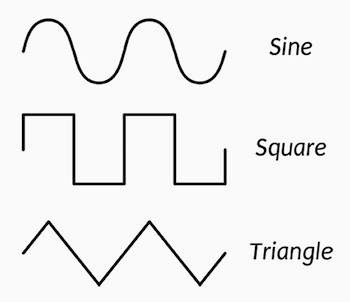
- Sine wave
- Square wave
- Triangle wave
Note: Although these waveforms are commonly used for sound synthesis we’re talking about using the shapes to control audio effects here, affecting the overall volume ‘envelope’ of our sounds – we aren’t synthesizing the shapes themselves.
Now, what’s the difference between these control choices?
The sine wave setting keeps the signal sounding fairly natural and varies the volume in a continuous and smooth manner. This is much like a human turning a volume dial up and down in a natural way.
The square wave setting controls the signal with an abrupt on or off setting which causes a sharp stuttering on/off sound. This is much like turning a switch on and off repeatedly.
The triangle wave setting is a less popular choice. It has the continuity of the sine wave mode, but with sharp rise and a sharp fall rather than the smooth sine shape. This mixes some of the abruptness and drama of the square wave “on/off” sound with the continuity of the sine wave.
There are also variations on the theme, in which you can fine tune or combine any of the above three, resulting in some complex waveforms; but you get the general idea!
Okay, some final words on tremolo. I’m sure you know what’s coming: all tremolo effects are available in compact form, rackmount form, and of course the ever-growing software plugin format. No longer are you tied to a guitar amp if you desire a little volume wobble in your sound!
As with anything, some sound good, some so-so, and some are fantastic.
A common complaint with some of the smaller compact units is that the overall volume of the signal drops when the unit is engaged. There are many simple and inexpensive modifications to rectify this, courtesy of the effects modification industry we discussed during our “distortion” talk!
Past that, let’s dive into…..
Vibrato
I won’t go into all that much explanation of this effect because it is fundamentally the same as a tremolo effect – but with this one crucial difference:
Vibrato modulates frequency (pitch) not volume (as a tremolo does).
The same basic controls are found in vibrato units as tremolo, and their primary mission is to control how far the pitch gets altered, how fast this happens, and when this happens. Pretty basic stuff.
Vibrato units need to be used carefully, as the constant varying of the signal’s pitch can get you sounding and playing “out of key” very easily. In the hands of a creative accomplished musician who possesses a good ear, the results can be haunting and beautiful. In the hands of, shall we say, a less ‘discriminating’ musician…
Most keyboards have pitch wheels today, which are basically a manually-controlled version of this effect. Guitar players also latched onto this effect when Boss introduced the (now out of production) VB-2. This particular effect fetches a king’s ransom on the used market!
As always, modern equivalents are to be found in all of the usual formats discussed above.
That should be all you need to know for the basics of vibrato – but it leads us neatly on to…
Pitch Transposing Effects
Just as the name says, these goodies can take an input signal, alter the pitch and feed it to the output simultaneously to create a harmony effect.
There are 2 basic forms of pitch transposers:
- Chromatic
- Intelligent
Chromatic units can be set to harmonize any musical interval you want, but with no regard to the actual musical key you are using. The result is that once you hit the particular note that should have a sharp or a flat, the unit will not be able to make the necessary adjustment to keep the “harmony” line in key.
Intelligent units on the other hand, can be programmed with a specific key in mind, so the interval set will correctly follow the accidentals of the preset key. Units range from basic compact pedals that can produce 1-2 intelligent harmony lines all the way to sophisticated pieces that can literally “do anything” to your signal, such as ones made by Eventide and T.C. Electronics.
Going into an electronic breakdown of the operation of pitch transposers requires and operation manual the size of an encyclopedia, but the general thread between all transposers is the same as most modulation effects; split the original signal and process the “wet” signal. The only real difference is the sophistication in choosing notes and the number of additional parts pitch transposers produce.
Wah-Wah effects
I thought it only fitting to end with the effect that we discussed in the mystery bonus question’s answer:
The mighty wah-wah!
The technical name for the electronic function of a wah is “envelope filter”. I know, it sounds more like a secret guidance system for the space shuttle than a musical effect!
As mentioned in the introduction to this article, the wah effect was originally designed to be the electronic substitute for the trumpet mute. Guitar players latched on to the original Italian-made Vox wah, and history was made.
Just like distortion, wah effects have found a wide musical audience, resulting in numerous mutations and variations of the wah theme. Cataloging these is beyond the scope here, but as you know by now; we are interested in the core characteristics of the effect. For the wah-wah, it’s this:
The input signal is passed through an inductor. An inductor allows the target frequency, the width, and the resonance peak (the frequency focus point where the signal is most pronounced) of a filter to be regulated manually (or automatically) by electronics, to produce a sweep through the entire frequency range of the effect. The musician controlling the wah can now expressively control, or actually simulate the muted trumpet effect of closing, opening or partly obscuring the mouth of the trumpet.
Guitar sounds take on a continuous singing and searing sound when used on lead lines, or can be used to play sharp “whaka-whaka” rhythm parts in the spirit of such classics as the theme to “Shaft”![]()
![]()
![]()
![]() . Some more classic examples of artists’ use of wah-wah are Hendrix, Clapton, and all the way to modern players like Joe Satriani.
. Some more classic examples of artists’ use of wah-wah are Hendrix, Clapton, and all the way to modern players like Joe Satriani.
Of course, it isn’t just guitarists who’ve had wah fever; musicians from keyboardists to harp players have been known to make use of this effect.
And to think… all this from a pedal effect that earned the name “Cry Baby” due to its ability to also mimic said sound!
Variations of this effect? All of the usual suspects. Compact, rackmount, software and even tube versions of this effect have sprung up!
A slight aside:
Having mentioned tube wah-wahs (yes, I swear they’re out there!) let me take one more moment of your time for an observation. Musicians in general have a fascination with all things “tube”. We (and I include myself) believe that tube gear has a better, warmer sound. (Those pesky geeeetar players!)
BUT!
Today’s technology really is advancing to the point where authentic “tube” tones can be had with modern technology. Not everything has to be a real tube effect. Sure, certain effects can sound better in their tube versions, but most effects don’t need this type of circuitry.
I’m not trying to fuel the ongoing war about tube vs. solid state.
I’m simply trying to impart this to you:
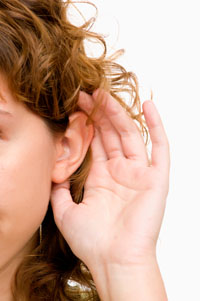 Please, use your ears when you select effects. That’s it. Don’t listen to the marketing or the hype. Listen to your ears. If something sounds better to you in the tube version, fine! If it sounds better to you in software version, fine as well! Get it? Those wonderful little flaps on either side of your head are the most wonderful musical tools you own. Use them.
Please, use your ears when you select effects. That’s it. Don’t listen to the marketing or the hype. Listen to your ears. If something sounds better to you in the tube version, fine! If it sounds better to you in software version, fine as well! Get it? Those wonderful little flaps on either side of your head are the most wonderful musical tools you own. Use them.
Then again, I am preaching to the choir; you are here at this site after all!
That concludes our basic tour of the basic effect archetypes available to you. But if you have any specific questions, please don’t hesitate to send me a question, via the comments or email.
I trust that I don’t need to tell you that the variations and different combinations of effects available now, truly are countless! I am confident though that you should now have the tools needed to venture out into the Wild, Wild West know as the “Effects World!”
It really is a great time to be a musician or audio specialist!
Good luck, and see you soon!

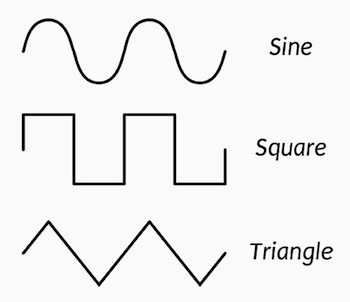

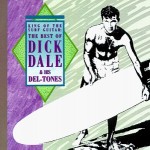






One of the best articals I have read explaining guitar distortion/effects. Wish I would have read this years ago, it would have saved alot of work and money.